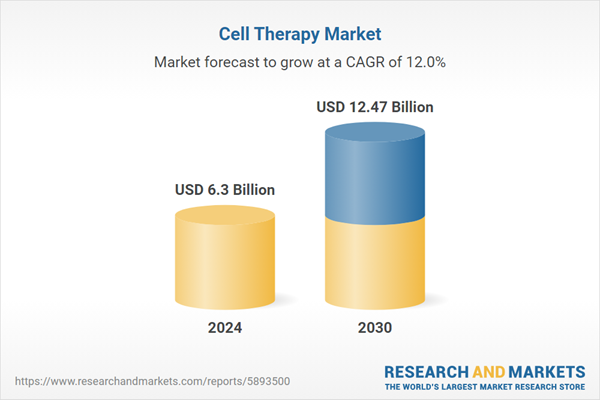Free Webex Call
The Cell Therapy Market was valued at USD 6.30 Billion in 2024, and is expected to reach USD 12.47 Billion by 2030, rising at a CAGR of 12.01%. In the realm of modern medicine, the convergence of science and innovation has given rise to transformative treatments that were once considered science fiction. One such groundbreaking advancement is cell therapy, a cutting-edge medical approach that harnesses the power of living cells to treat a range of diseases and conditions. The global cell therapy market is rapidly expanding, offering new hope for patients and creating a paradigm shift in the way healthcare is delivered. Speak directly to the analyst to clarify any post sales queries you may have.
10% Free customizationThis report comes with 10% free customization, enabling you to add data that meets your specific business needs.
Cell therapy involves the transplantation or manipulation of living cells into a patient's body to stimulate the repair, regeneration, or replacement of damaged or diseased tissues. These cells can be sourced from the patient's own body (autologous) or from a donor (allogeneic). The therapeutic potential of cell therapy lies in its ability to target the root causes of various diseases at a cellular level, unlike traditional treatments that often focus on symptom management. The global cell therapy market has gained substantial momentum in recent years due to its promising outcomes and a growing understanding of cellular biology.
Key Market Drivers
Increasing Prevalence of Chronic and Degenerative Diseases
The rising prevalence of chronic and degenerative diseases is one of the primary factors fueling the expansion of the Global Cell Therapy Market. In 2020, an estimated 523 million individuals globally were affected by cardiovascular diseases (CVDs), with approximately 19 million fatalities attributed to these conditions. This accounted for nearly 32% of all global deaths and reflected an 18.7% increase in absolute mortality compared to 2010. As conventional treatment methods often fail to provide long-term solutions for these conditions, cell therapy is emerging as a breakthrough alternative, offering regenerative and disease-modifying potential.In 2021, noncommunicable diseases (NCDs) were responsible for at least 43 million deaths worldwide, accounting for 75% of all non-pandemic-related fatalities. Alarmingly, 18 million of these deaths occurred in individuals under the age of 70, with 82% of premature fatalities concentrated in low- and middle-income countries. This growing burden highlights a significant unmet medical need for more effective, accessible, and preventive healthcare solutions, particularly in regions with limited resources. Chronic and degenerative diseases such as cancer, cardiovascular diseases, autoimmune disorders, diabetes, and neurodegenerative conditions pose a significant global healthcare burden.
Traditional treatment options, including pharmaceuticals and surgical interventions, often provide only symptom relief rather than disease reversal or regeneration. Cell therapy, particularly stem cell and immune cell-based treatments, offers a transformative approach by promoting tissue regeneration, reducing inflammation, and potentially curing previously untreatable diseases. As the global population ages and chronic disease prevalence rises, demand for more effective, long-term solutions is accelerating investment and adoption of cell therapies.
Key Market Challenges
Complex Regulatory Landscape
One of the foremost challenges in the cell therapy market is navigating the complex and evolving regulatory landscape. Unlike traditional pharmaceuticals, which are based on small molecules, cell therapies involve live cells that interact with the patient's body. This dynamic nature raises unique safety and efficacy concerns, leading to intricate regulatory requirements. Ensuring compliance with these regulations can be time-consuming and resource-intensive, potentially delaying the development and approval process.Key Market Trends
Technological Advancements
The field of medical science is undergoing a transformative phase, with remarkable breakthroughs occurring at an unprecedented pace. Among these groundbreaking advancements, cell therapy stands out as a beacon of hope, promising revolutionary treatments for a multitude of diseases that were once considered untreatable. As technological innovations continue to accelerate, the cell therapy market is experiencing a rapid expansion, offering new avenues for treating a diverse range of medical conditions. Stem cells, with their unique ability to differentiate into various cell types, have captured the attention of researchers and clinicians alike.Advances in stem cell isolation, manipulation, and differentiation techniques have enabled the development of personalized therapies for conditions ranging from neurodegenerative disorders to cardiovascular diseases. The emergence of precise gene editing tools like CRISPR-Cas9 has revolutionized the field of cell therapy. This technology allows scientists to modify a cell's genetic material, correcting mutations or enhancing desired traits before transplantation. Gene-edited cells offer improved therapeutic potential and reduced risks of immune rejection. Immunotherapies harness the body's immune system to target and destroy disease-causing cells.
Chimeric Antigen Receptor (CAR) T-cell therapy, a form of immunotherapy, has shown remarkable success in treating certain types of leukemia and lymphoma. Ongoing research aims to expand the applications of CAR-T therapy to solid tumors and other diseases. Microfluidic devices and automated systems have streamlined the production and manipulation of cells for therapy. These technologies enhance scalability, consistency, and quality control, ensuring that cell-based treatments can be manufactured in large quantities without compromising safety and efficacy. As technology continues to evolve, the cell therapy market is projected to experience exponential growth.
The convergence of these technological advancements has propelled the development of novel and effective therapies for conditions that were once considered incurable. From autoimmune diseases to degenerative disorders, the spectrum of diseases that can potentially be addressed through cell therapy continues to expand. However, it's important to note that along with the potential benefits, challenges remain. Safety concerns, regulatory hurdles, and the complexities of manufacturing consistent and viable cell therapies on a large scale are among the issues that need to be addressed to fully realize the potential of this field.
Key Market Players
- Novartis AG
- Gilead Sciences, Inc.
- Bristol-Myers Squibb Company
- Johnson & Johnson Services, Inc
- JCR Pharmaceuticals Co., Ltd.
- Tego Science
- Atara Biotherapeutics
- Takeda Pharmaceutical Company Limited
- Bluebird Bio, Inc.
- Dendreon Corp.
Report Scope:
In this report, the Global Cell Therapy Market has been segmented into the following categories, in addition to the industry trends which have also been detailed below:Cell Therapy Market, By Therapy Type:
- Autologous
- Allogenic
Cell Therapy Market, By Therapeutics Area:
- Oncology
- Cardiovascular Diseases
- Musculoskeletal Disorders
- Dermatology
Cell Therapy Market, By Region:
- North America
- United States
- Canada
- Mexico
- Europe
- France
- United Kingdom
- Italy
- Germany
- Spain
- Asia-Pacific
- China
- India
- Japan
- Australia
- South Korea
- South America
- Brazil
- Argentina
- Colombia
- Middle East & Africa
- South Africa
- Saudi Arabia
- UAE
Competitive Landscape
Company Profiles: Detailed analysis of the major companies present in the Global Cell Therapy Market.Available Customizations:
With the given market data, the publisher offers customizations according to a company's specific needs. The following customization options are available for the report.Company Information
- Detailed analysis and profiling of additional market players (up to five).
This product will be delivered within 1-3 business days.
Table of Contents
1. Product Overview
2. Research Methodology
3. Executive Summary
5. Cell Therapy Market Outlook
6. North America Cell Therapy Market Outlook
7. Europe Cell Therapy Market Outlook
8. Asia-Pacific Cell Therapy Market Outlook
9. South America Cell Therapy Market Outlook
10. Middle East and Africa Cell Therapy Market Outlook
11. Market Dynamics
12. Market Trends & Developments
14. Competitive Landscape
Companies Mentioned
- Novartis AG
- Gilead Sciences, Inc.
- Bristol-Myers Squibb Company
- Johnson & Johnson Services, Inc
- JCR Pharmaceuticals Co., Ltd.
- Tego Science
- Atara Biotherapeutics
- Takeda Pharmaceutical Company Limited
- Bluebird Bio, Inc.
- Dendreon Corp.
Table Information
| Report Attribute | Details |
|---|---|
| No. of Pages | 185 |
| Published | March 2025 |
| Forecast Period | 2024 - 2030 |
| Estimated Market Value ( USD | $ 6.3 Billion |
| Forecasted Market Value ( USD | $ 12.47 Billion |
| Compound Annual Growth Rate | 12.0% |
| Regions Covered | Global |
| No. of Companies Mentioned | 10 |









